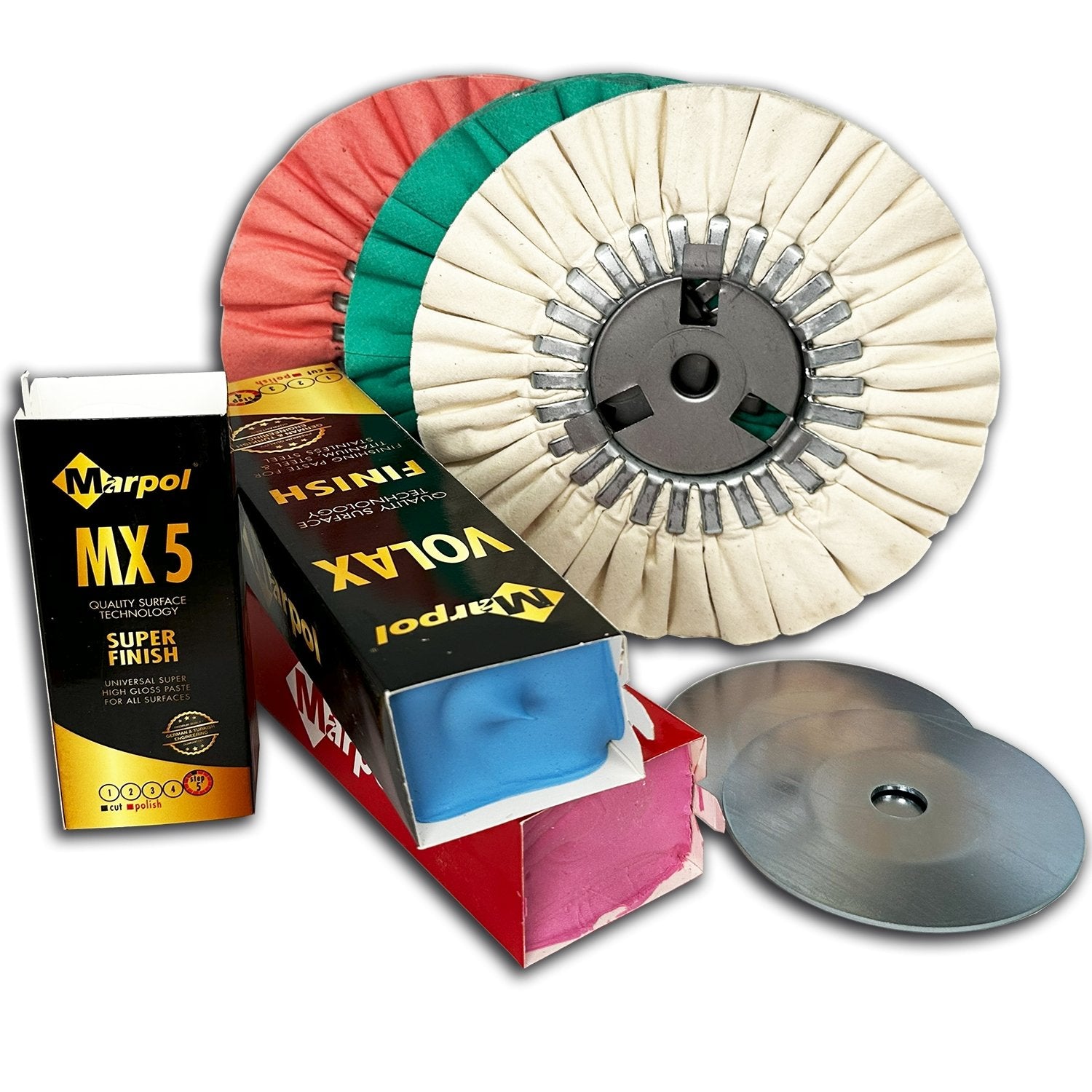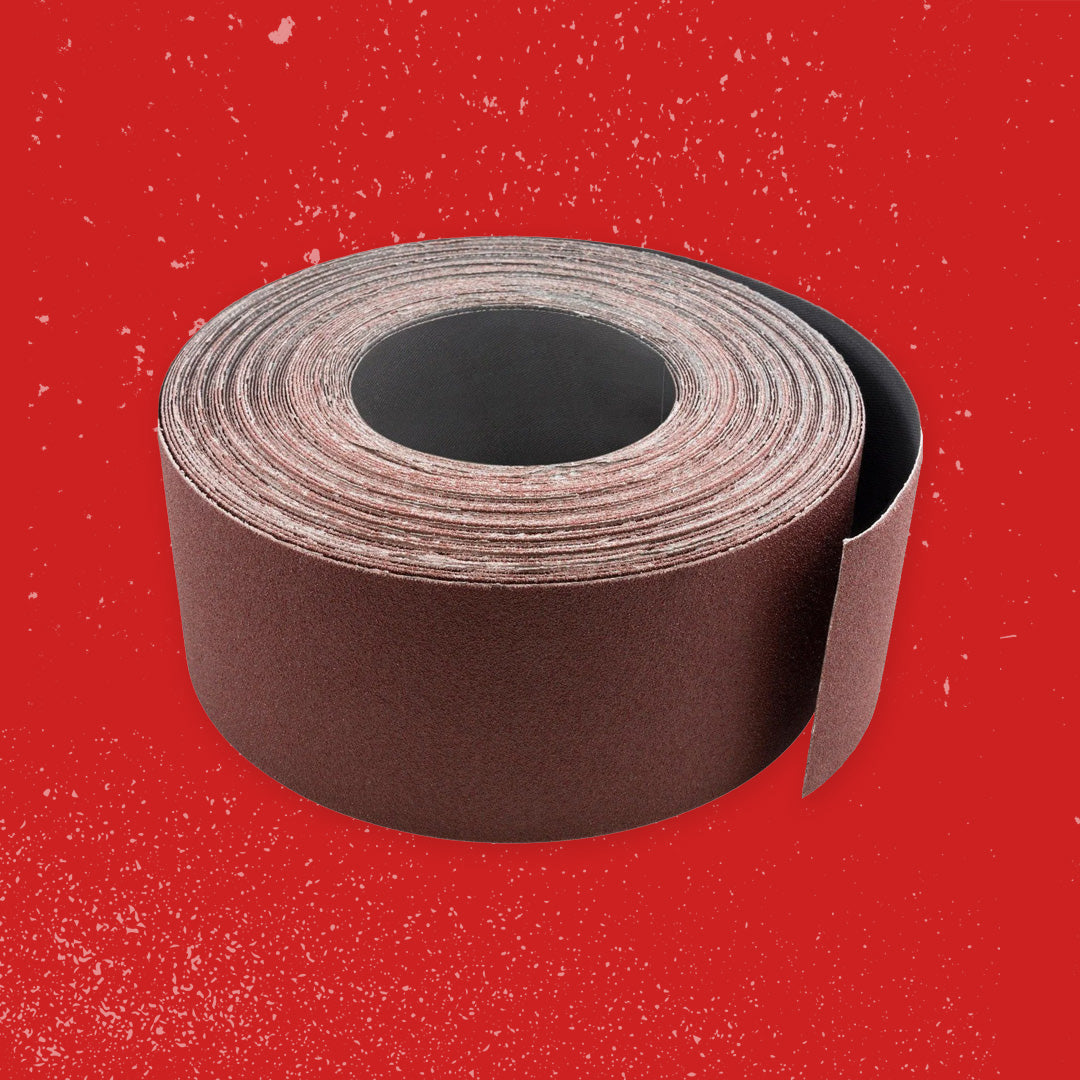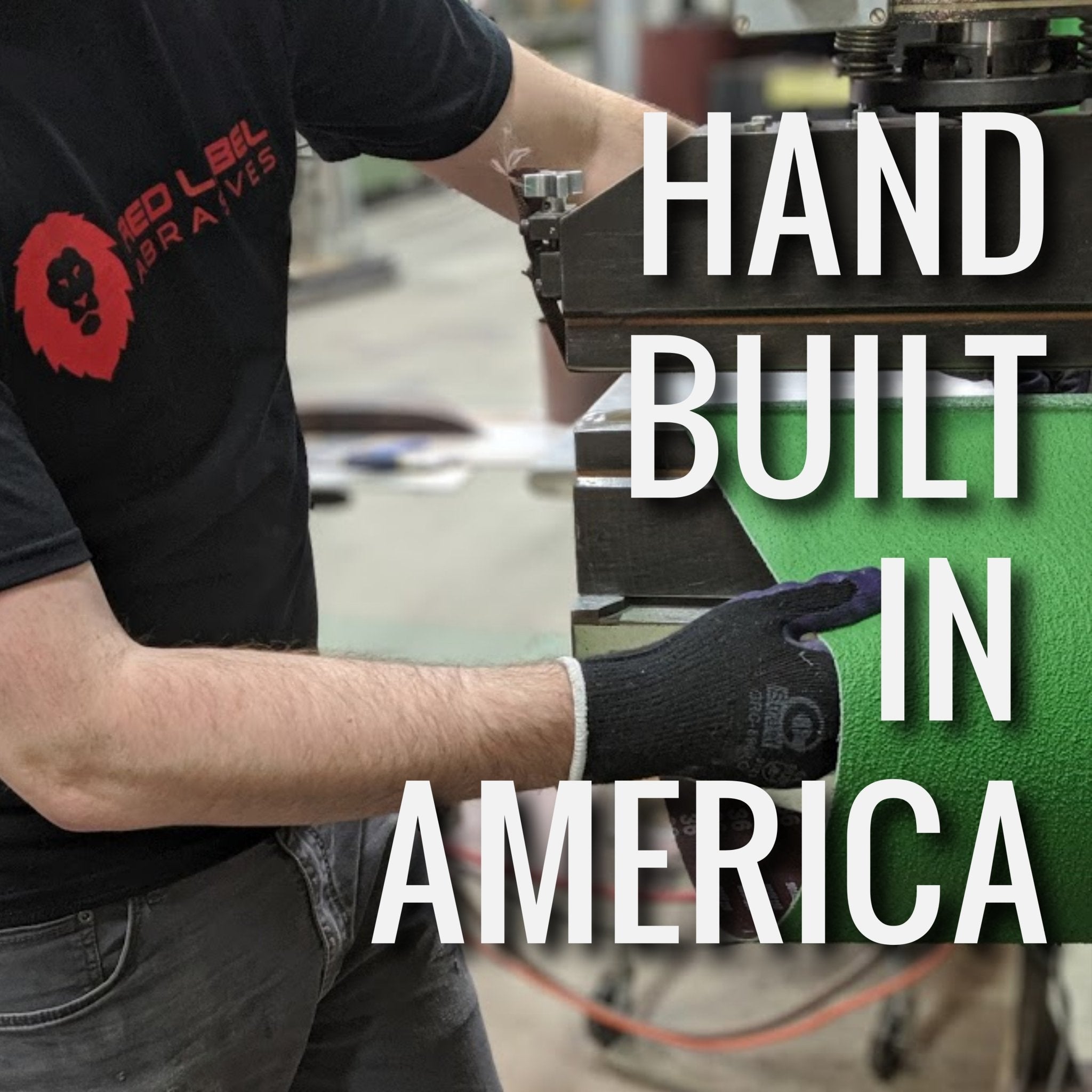Your Cart is Empty
Free Shipping over $150 (Excludes Oversized Products)
Free Shipping over $150 (Excludes Oversized Products)
Sanding Belts
Sanding Discs

What Are The Best Sanding Discs For Automotive Work?
by David Kranker 7 min read

Quick Summary
Sanding discs are essential for any automotive project, whether you’re stripping paint, smoothing imperfections, or achieving a high-gloss finish. The right disc depends on your material and task: coarse grits (40–120) are ideal for removing rust or paint, while finer grits (400–5000) create smooth, polished surfaces ready for paint or sealing. The hook and loop orange discs provide excellent durability, fast cutting, and wet/dry compatibility, making them perfect for curves, corners, and uneven surfaces. For high-gloss finishing, Abrasilk foam-backed discs prevent pressure marks, deliver consistent results, and reduce dust with their breathable design. By choosing the right grit progression and tools, you’ll ensure professional results at every stage.
Sanding discs are a must-have for any automotive project. From prepping a surface for paint and smoothing out imperfections to achieving a flawless showroom finish, the right product can help you achieve professional results. But with so many options on the market, how do you determine which sanding disc is the perfect fit?
Fortunately, choosing the right one doesn’t have to be complicated or involve guesswork. The key is understanding your project needs in advance. In other words, what material will you be working with? What’s the nature of the task itself? What’s the ideal outcome?
In this blog, the team at Red Label Abrasives makes it simple. We’ll cover what makes a sanding disc ideal for automotive work, spotlight the standout features of our town sanding discs, and help you pick the right grit and material for every stage of your project. By the time you’re done reading, you’ll know exactly what to look for, and why Red Label Abrasives should be your go-to choice.
Key Features of Automotive Sanding Discs
With automotive sanding, you need sanding discs that are made from premium materials and built to last. If you’ve never bought them before or are looking to switch your current product for something more reliable, here are some tips to get you started.
-
Reliability:Automotive projects often involve extensive sanding on tough materials. High-quality sanding discs should maintain their performance and resist wear over time. Polyester film-backed discs offer superior strength compared to traditional paper-backed options.
-
Multi-Surface Compatibility: Automotive sanding involves various materials like paint, primer, fiberglass, plastic, and metal. A good sanding disc should perform well on all of these surfaces.
-
Wet and Dry Sanding: Wet sanding (also referred to as color sanding) is used in automotive work to achieve a flawless finish and reduce dust. Discs that work well in both wet and dry conditions are highly recommended.
-
Fine Finish Capability:For tasks like high-gloss finishing, you’ll want to use sanding discs that reduce the risk of pressure marks and leave a uniform finish. Foam-backed discs are ideal for this purpose.
-
Grit Selection: Automotive projects often require a range of grits, from coarse discs for heavy material removal to ultra-fine discs for polishing. Having an assortment of grits ensures you’re prepared for every stage of the project.
The Top Sanding Discs for Automotive Work
The right sanding disc can make or break your automotive project. To make the search easier, we’ve rounded up the top sanding discs for automotive work: these products are engineered to help you achieve professional-level results more easily.
Hook and Loop Orange Sanding Discs
Red Label Abrasives’ hook and loop orange sanding discs are among the most resilient and practical options for automotive work. These discs are manufactured with a premium polyester film backing and industrial-grade aluminum oxide abrasive grain. Here’s why they’re an excellent choice for your project:
-
Wet and Dry Sanding: Whether you’re dry-sanding body filler or wet-sanding primer for a flawless paint job, these discs perform exceptionally well in both applications.
-
Durability: The polyester film backing offers superior strength and flexibility compared to paper-backed discs. This makes them ideal for sanding curves, corners, and uneven surfaces without cracking or tearing.
-
Fast Cut Rate: The aluminum oxide grain ensures a quick and efficient cut, reducing the time spent on each task while still delivering long-lasting performance.
-
Versatility:These discs are not limited to automotive paint: they also work on fiberglass, plastic, composites, and even marine surfaces.
If you need a reliable all-around sanding disc for various automotive applications, these hook and loop orange discs are a standout choice.
Abrasilk Sanding Discs with Foam Backing
For high-precision finishing tasks, many customers turn to Red Label Abrasives’ Abrasilk sanding discs with patented foam backing. Designed specifically for automotive paint and high-gloss finishes, these discs are packed with features that make them a favorite among professionals:
-
Uniform Finish:The foam backing reduces the risk of pressure marks, making it ideal for sanding angled edges, rounded surfaces, and intricate contours.
-
Wet and Dry Applications:The bonded aluminum oxide abrasive performs equally well in wet or dry conditions, giving you flexibility for a variety of tasks.
-
Dust Control:The ultra-breathable foam reduces surface temperature, extends disc life, and ensures compatibility with dustless sanding systems. This creates a cleaner, healthier workspace.
-
Wide Grit Range:Abrasilk discs come in a range of grits, from 500 to 5000, allowing you to tackle everything from material removal to ultra-fine polishing.
These foam-backed discs are perfect for achieving a flawless finish on automotive paint, primer, and even nonferrous metals.
Choosing the Right Grit for Automotive Applications
In automotive work, it’s common to use multiple grits in a progression, starting with coarse options for heavy-duty tasks and working toward finer grits for a mirrorlike finish. Understanding when and how to use different grit levels can help you achieve professional-quality results.
Coarse Grit (40–120)
Coarse grit sanding discs are designed for heavy material removal. They’re ideal for tasks like:
-
Stripping old paint
-
Leveling out imperfections in metal or body filler
These grits quickly tackle rough surfaces to prepare them for more detailed work. While effective, their aggressive nature can leave noticeable scratches, which is why they’re typically followed by medium or fine grits to refine the surface.
Medium Grit (180–320)
Medium grits are perfect for shaping body filler, feathering edges, or smoothing out primer. They’re also excellent for blending repaired areas into existing surfaces. Medium grit discs are less aggressive than their coarse counterparts, which means they create a smoother finish without sacrificing efficiency. For most automotive projects, this grit range serves as a transition stage between heavy-duty sanding and fine detailing.
Fine Grit (400–800)
Fine grit sanding discs are ideal for finishing primer, sanding clear coats, and preparing surfaces for polishing or painting. By the time you’re working with these grits, the goal is to remove minor imperfections and create a smooth foundation for the final finish. This grit range is key to achieving a professional-quality appearance, especially when working on visible parts of a vehicle.
Ultra-Fine Grit (1000–5000)
These sanding discs are designed for high-gloss finishing. Ultra-fine grits are also used for removing swirl marks, fine scratches, or hazing caused by earlier sanding stages. Wet sanding with these grits ensures a smooth, streak-free finish, leaving the surface ready for waxing or sealing.
With Red Label Abrasives’ assortment packs, you have access to the full spectrum of grits needed for any automotive project. From tackling rust to perfecting a high-gloss finish, our sanding discs deliver consistent results at every stage of the process.
How to Sand Different Automotive Surfaces
When you’re sanding an automotive surface, your approach should be based on the material you’re working with. Each surface has its own properties and challenges, so selecting the right grit and technique is key to achieving professional results. Below, we’ll break down how to sand various automotive surfaces.
Automotive Paint
Sanding automotive paint is all about achieving a smooth, polished finish without damaging the surface.
Begin by using 400–600 grit sanding discs to remove imperfections, such as minor scratches or uneven paint application. This stage smooths the surface and prepares it for finer sanding. Once the surface is uniform, progress to finer grits, typically in the 1000–3000 range, for wet sanding. Wet sanding minimizes dust, reduces surface temperature, and helps you achieve a polished, glass-like finish.
Pro Tip:To avoid pressure marks or uneven results, opt for foam-backed sanding discs. These discs provide a consistent finish, especially on curved or angled surfaces.
Primer
Primer serves as the foundation for your paint job, so achieving a smooth base is important. Start with 320–400 grit sanding discs to smooth the primer and eliminate any application flaws, such as streaks, drips, or uneven texture. This step ensures that the surface is level and ready for further refinement.
To finalize the prep work, move to finer grits in the 600–800 range. This stage creates a perfectly level surface for paint to stick to, reducing the risk of imperfections in the final finish. Wet sanding can also be beneficial at this stage, particularly when working with higher grits, as it helps create a cleaner, more even surface.
Metal
Metal surfaces often require heavier sanding in the early stages. To remove rust, old paint, or stubborn coatings, begin with coarse grits in the 40–80 range. These discs aggressively strip away unwanted layers, exposing a clean surface for the next steps.
After the heavy material removal is complete, smooth the surface using medium grits, typically in the 180–320 range. This stage helps refine the metal and prepare it for primer or paint. Properly sanding metal ensures that coatings stick evenly and reduces the chances of peeling or bubbling down the line.
Fiberglass and Plastics
Fiberglass and plastics require a gentler approach due to their softer and more heat-sensitive nature. Begin shaping and smoothing these surfaces with 180–220 grit sanding discs. This grit level is ideal for removing rough edges or sanding down excess material without causing damage.
For finishing or preparing these materials for paint, transition to finer grits in the 320–600 range. Wet sanding is highly recommended for fiberglass and plastics, as it reduces heat buildup that could warp or damage the material. Wet sanding also helps minimize clogging, ensuring a cleaner surface and prolonging the life of your sanding discs.
By using the appropriate techniques and grit levels for each material, you’ll achieve better results while protecting the integrity of the surface. With Red Label Abrasives’ high-performance sanding discs, you can count on consistent quality and the versatility needed for all your automotive projects.
Buy Your Automotive Sanding Discs at Red Label Abrasives
Choosing the best sanding discs for automotive work depends on the task at hand, the materials you’re working with, and the level of finish you’re aiming for. Red Label Abrasives’ hook and loop orange sanding discs and Abrasilk foam-backed discs have multiple advantages that make them ideal for automotive applications.
Whether you’re repairing paint, smoothing primer, or achieving a high-gloss finish, these discs provide the performance and reliability you need to get the job done right. Ready to take your automotive projects to the next level? Explore Red Label Abrasives’ full range of sanding discs today! For more information or to place an order, call 844-824-1956 or fill out our contact form today.
ABOUT THE AUTHOR
David Kranker is a writer and creative maker who has been covering the abrasive industry on the Red Label Abrasives Blog since 2020. David spends his time continually researching sanding techniques to provide readers with the latest and greatest information. In his free time, David utilizes abrasives for many different home and auto projects at his home in Delton, MI.
Our Most Popular Abrasives

EdgeCore Ceramic Sanding Belts

EdgeCore Ceramic Flap Discs

Buffing Kit
Shop By Product Category





Why Choose Red Label?







